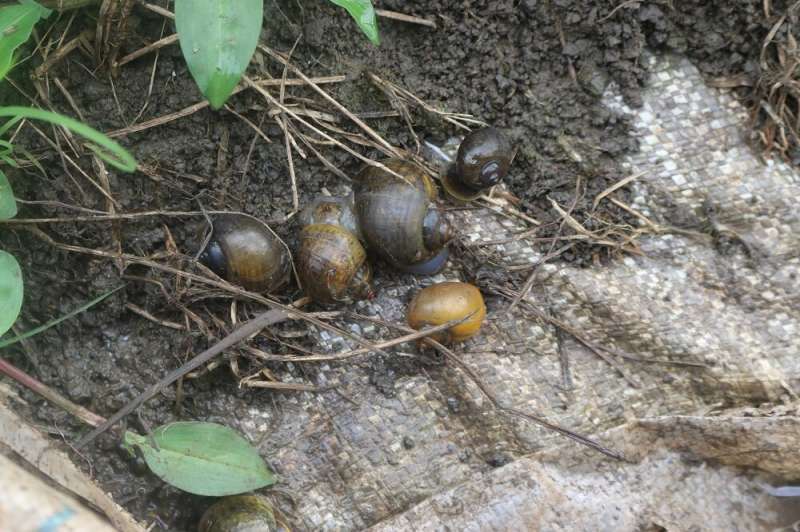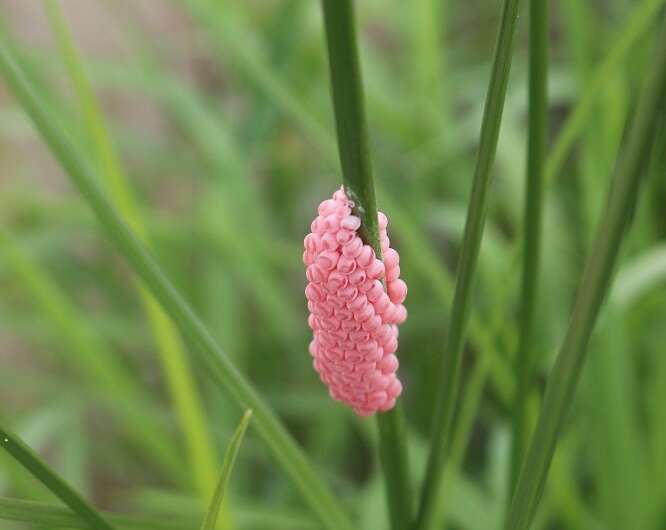New research confirms presence of highly invasive apple snail in Kenya

New research published today by scientists at CABI and the Kenya Plant Health Inspectorate Service (KEPHIS) confirms that the apple snail (Pomacea canaliculata) has been discovered in Kenya for the first time. Widely considered to be one of the most invasive invertebrates of waterways and irrigation systems, the apple snail threatens Kenya's rice production and raises the questions: How much damage will it cause in Kenya, and will it spread further?
The scientists, including lead author and senior molecular microbiologist at CABI, Dr. Alan Buddie, published their study, "First report of the invasive apple snail, Pomacea canaliculata in Kenya," in CABI Agriculture and Bioscience. The paper was also posted as a preprint to agriRxiv in December 2020.
The discovery came following reports of an invasive snail causing crop damage in the expansive Mwea irrigation scheme in Kenya, where samples of snails and associated egg masses were collected and sent to CABI laboratories in the UK for molecular identification. DNA barcoding analyses using the cytochrome oxidase subunit I gene, supplemented by elongation factor 1-alpha sequencing, confirmed the identity of the snails as Pomacea canaliculata, a pest indigenous to the Americas.
This timely identification shows the benefit of molecular identification when combined with a reliable database such as that provided by the Barcoding of Life Data system. CABI found that the egg masses tested gave an identical barcode sequence to the adult snails, allowing identifications to be made more rapidly.
Pomacea canaliculata is listed among 100 of the world's worst invasive species. Its introduction and spread in Southeast Asia was thought to be largely due to intentional introduction and it has become a serious agricultural and ecological pest, causing significant economic losses in wetland rice cultivation and threatening biodiversity.

Quickly assessing and addressing the potential invasive species threat is essential. Farmers in Kenya are already talking about the damage caused to rice in Mwea, where over 70% of the country's rice is grown.
Given the impact of this species in Asia, there is need for an assessment of the risk in Africa and the implementation of an appropriate response in Kenya and elsewhere to manage this new threat to agriculture and the environment.
Prof. Theophilus Mutui, managing director of KEPHIS, said, "Since its first point of detection in Mwea, apple snail has spread gradually to other areas. Strict quarantine measures should be instituted and implemented to curb not just the spread of the snail, but entry into other rice-producing risk areas in the country. To achieve this, areawide management should be exercised, such as training and raising awareness, installation of physical barriers, mechanical control, and community-based snail management."
Dr. Alan Buddie, lead author and senior molecular microbiologist at CABI, said, "Molecular tools provide an invaluable aid to species-level identifications within groups of organisms that look almost identical to non-specialists. In the present case, taxonomic experts in this group of invertebrates are rare. We demonstrated that as long as we can obtain a small amount of DNA from a snail, or even a single egg, we can obtain the same level of identification if experts have deposited authenticated sequences in public-access sequence databases."
Dr. Ivan Rwomushana, senior scientist, invasive species management, CABI, said, "We collected samples of the snail for barcoding. Following confirmation of the new species, we completed a delimiting survey to establish the extent of snails' spread. Our findings show that other schemes are still unaffected, although seed and machinery brought from Mwea poses a risk for invasion. We will work with the relevant national agencies to develop a rapid response and containment strategy for this new invasive species."
More information: Alan G. Buddie et al, First report of the invasive snail Pomacea canaliculata in Kenya, CABI Agriculture and Bioscience (2021). DOI: 10.1186/s43170-021-00032-z
Provided by CABI


















